1. England 1150-1220
On this page, the context of medieval England will be given followed by important notions of how the society was structured, organised and governed. It will be helpful background knowledge for the life of Richard as well as the key events surrounding his life.
Guiding Questions:
What was life like in Medieval England?
What was the feudal system and its effect on life in England?
What was the government like in medieval England?
How does the life and governance in England relate to Richard I?
The material in this page is additional background information and is not part of the syllabus content for the Paper 1 Prescribed Subject. However, it is given here for supplementary purposes.
It is always worth investing time to research context and developments at least a century before Richard and a century after.
Life and Government in England 1150-1200
1.1. Feudal Hierarchy
England in the 12th century and before, was constituted with a very rigorous feudal hierarchy from the legacy of William the Conqueror after 1066. See the short video below:
See the diagram below:

The video below is a short presentation on the medieval feudal system
Power, rights and wealth were distributed unequally among the population. Society was grouped in that the higher up the scale you climbed, the more wealthier and powerful you became. If you were born a villein (un-free peasant) for example, the likelihood was you would remain one until you died. Each strata (group) within the social scale (ladder) had its own value or 'price', known as wergild (= Old English for "man payment") which is the amount of compensation you would have to pay for injuring or killing someone. For example, if you killed a barren or a knight, you would have to pay 1,200 shillings as compensation. If you killed a villein (peasant), you would probably pay something in the amount of 200 shillings.
Monarchs: At the top of the Feudal Hierarchy was the Monarch - The King. This is where Richard I would be. Monarchs owned land, vast amounts of riches and wielded immense power. They had the authority and capacity to reward people with positions of power. The Monarch was sovereign which meant he decided the nature of governance and the laws to be passed. Much of the hos income was through taxes or acquisition of property (money, land, etc.).
Barons: these were the wealthy category of people who owned great amounts of land given to them by the king (sometimes referred to as tenants-in-chief) but never worked on it. They would pretty much own the land for life. They were granted the land as a reward for their fidelity to the king when conquering territories in order to help him administer the kingdom. They would also ensure the monarch had support from sufficient numbers of knights in order to protect the monarch's interests. Thus, the baron's rank and status was not far below the monarch.
Barons stood to gain immensely from their loyalty to the king. However, managing them was not always easy. Many kings had problems controlling these barons and some even revolted. Refer to the revolt against Henry II (that included Richard himself) which is dubbed "The Barons' Revolt".
Knights: In most cases, knights were younger sons of barons (the nobility but not always so) who were sent on training to become fighters and worthy of acquiring an elite title. The feudal system allowed knights who were successful in their training and achievement to gain land for military service. A portion of land (called a fief) would be granted by the king to a successful knight who had performed well during battle(s). This reward would be granted in exchange for his services. Thus, knights in exchange would swear fealty or an oath to be loyal to the King. Something also known as homage. Fealty and homage were key elements within feudalism as it allowed control and subservience.
Knights had a wider function too which included:
they served on juries for legal cases.
they worked in the local communities (community servants).
they were appointed as sheriffs.
they were appointed into administrative roles.
Knights would also be pressed into service for barons. They would be given land and in return they would remain loyal to their baron lord and offer military service when needed.
Below, a medieval miniature on homage:
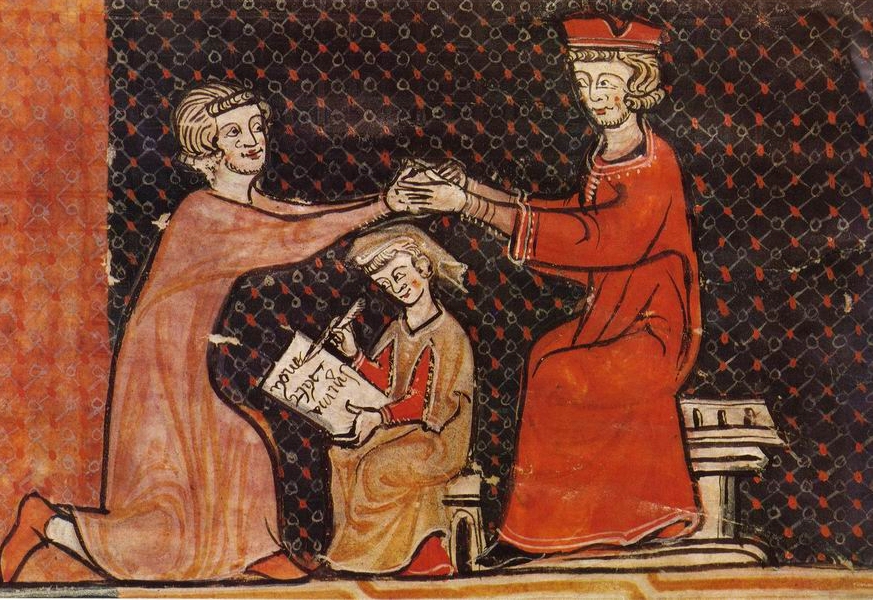
[Courtesy of Wikipedia]
Villeins: these were unfree peasants and comprised much of the population of England at that time. They worked on their landlord's land (labour service) and in return they were allowed to use a segment of it to live off. They had minimal rights and needed permission from their landlord for rights that we would today consider basic and unquestionable. For example, villeins could not leave their village (manor) without permission from their lord and they could be bought and sold.
Knowledge Check
Watch the videos on feudalism below:
Questions:
1. What is feudalism?
2. Why were barons important within the feudal hierarchy? Explain your answer.
3. How did feudalism benefit the king? Explain one way it did.
4. How important were knights within the feudal hierarchy? Explain your answer.
The system in England during the time of Richard was feudal. As already outlined, the evident relationship within this system centred around land and who owned land (known as landholding). All land ultimately belonged to the king and peoples of all strata (from richest to poorest) held land only from and by permission of the king. Land would be parceled out by the king based on what he saw as his political and economic interests. Those directly given land were tenants-in-chief and they in turn would make others work on the land as indirect tenants. Anyone suspected by the king of undermining his political or economic interests or committed a serious crime would forfeit their right to the land (known as forfeiture).
Land distribution around the late 12th century approximately was:
20% = owned by the crown (known as the royal demesne).
25% = owned by the Church.
50% = owned by the barons (leading nobles in the land).
The effects of the feudal type system:
Decentralised government which meant more feuds and warfare due to weaker centralised control of power.
Castles were built by barons/lords in order to protect and defend their lands.
Governance essentially was through alliances between the monarch and the barons (nobles).
Rigid hierarchical society which meant there was no opportunities for social (upward) mobility for serfs/peasants and hence power structures were never shifted.
Generally weaker kings because the king depended on loyalty military aid from the barons.
Land defined the relationship between the rich and poor in society.
People were bound by loyalty (to one's lord) and needs.
The merits and demerits of the Feudal System:
Merits:
- Stability to the kingdom: where the poorest worked to maintain the infrastructure of necessary goods and services.
Demerits:
Subsistence living: where the poorest had to forfeit virtually everything to keep their homes by working on the land.
Compounded hardship: were often heavy taxes levied on the poorest who had to pay it.
No rights or independence for the poorest.
The church and the lords were the judge and jury when it came to legal matters.
Debate:
As a class, debate the merits and demerits of the feudal system.
One source to help you think about and develop your points is here.
1.2. Life in the Countryside
Nearly everyone in the middle ages lived in villages in the countryside. Features of the medieval countryside included:
Land surrounding the village (called a manor).
The land was held and controlled by a baron or knight.
Daily life involved or revolved around the land: (a) ploughing and harvesting for food; (b) spinning wool from sheep for making clothes and blankets; (c) tilling the land/soil, etc.
Disease was common due to lack of adequate hygiene systems.
Life expectancy was low.
Below are illustrations from the Luttrell Psalter that offer a glimpse into the medieval countryside:
The Luttrell Psalter, British Library Add. MS 42130:
The Psalms are 150 ancient songs, grouped together to form one of the Old Testament books of the Bible. In the Middle Ages (and down to the present day) they formed a fundamental part of Christian and Jewish worship, for ecclesiastics and lay-people alike; many people learnt to read by being taught the Psalms. The Psalms were often written out separately from the rest of the Bible, preceded by a calendar of the Church’s feast-days, and followed by various types of prayers. Such a volume is known as a Psalter.
The Luttrell Psalter is the celebrated manuscript commissioned by a wealthy landowner Sir Geoffrey Luttrell in the first half of the 14th century. It is one of the most striking to survive and the manuscript is unlike virtually any other. It depicts agricultural and social life in the the manor of Irnham in Lincolnshire within the Middle Ages in rich colours embellished with gold and silver, with vitality and sometimes bizarre inventiveness of decoration.
Ploughing:
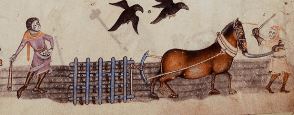
Harvesting:
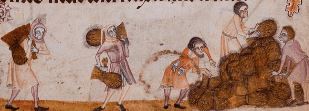
Tilling:
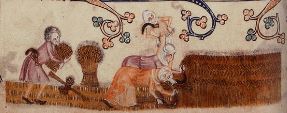
1.3. Life in the Towns
Features of Medieval English towns included:
Market places for trading local and international goods which would also have regular fairs.
Residences with bustling thoroughfares.
Churches which provided protection and sources of employment.
Animal areas to breed cattle and sell them.
Fortification of the town through walls and ditches.
A village had to apply to the king for right to be a town. This would give it privileges such holding markets and events in order to make money.
Taxes had to be paid to the king or lord for holding markets.
Poor hygiene meant dirt and smells with no sanitary system. This lead to rapid spread of diseases and illnesses.
Life expectancy was low.
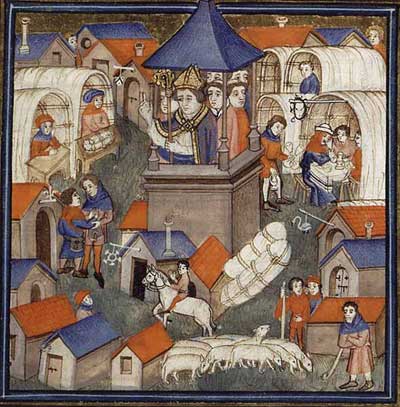
[an artist's impression of a medieval town]
1.4. Role of the Church
The medieval belief was that God determined their lives and determined a hierarchy of lives. God also determined outcomes and so pleasing God in daily life was important.
The means to ensure one pleases God and reach heaven were religious figures like Church priests. Every village or town had a church with priests. They would undertake charity and help the less fortunate in addition to teaching literacy in exchange for a tithe (usually the value of a tenth of the crops for that year). Priests would instruct the people on living a religious life such as attending church service (known as mass) every Sunday.
The Church held immense power not only because of the large swathes of land it owned but because of its function and influence:
a) The Church represented God and so held huge religious significance and allegiance for the people.
b) Religion was part of the daily and social life of the people as it offered services, assistance and shelter. Almost everyone was Christian in England attended church.
c) The Church had the power to almost determine the afterlife of a person (whether they would go hell or heaven). This enabled people to be controlled and regulated in a religiously subservient way as people wanted to avoid hell.
d) The church would be pilgrimage sites for many people and so attracted not only religious interest but commerce as well.
e) The religious officials of the church (the clergy) used their position, knowledge and power to influence the political and cultural life of the society.
f) Churches would also have monasteries adjacent to it where monks would remove themselves from public life and devote themselves to worship, prayer and meditation. They would also preserve and teach theological and philosophical works in Latin.
1.5. Monarchical Governance
.svg.png)
Medieval kingship involved ceremonies, rituals and public display of functions and paraphernalia. It also involved ideas about the kind of monarch and monarchical governance that was expected and required. Below are some of the key aspects in this regard:
Coronation: This ceremony was an important ritual. In England, kings were crowned at Westminster Abbey. Here, the king to be would be led by procession to the high alter and anointed king with sanctified holy oil. Thus, the Church was instrumental in its role of king-making. A king derived religious authority only after being anointed. The king would make an oath in order to protect the church and be just to all in the kingdom.

[Richard I being anointed during his coronation in Westminster Abbey, from a 13th-century chronicle /
courtesy of Wikipedia].
The source below is a 15th century artist impression of Richard's procession:
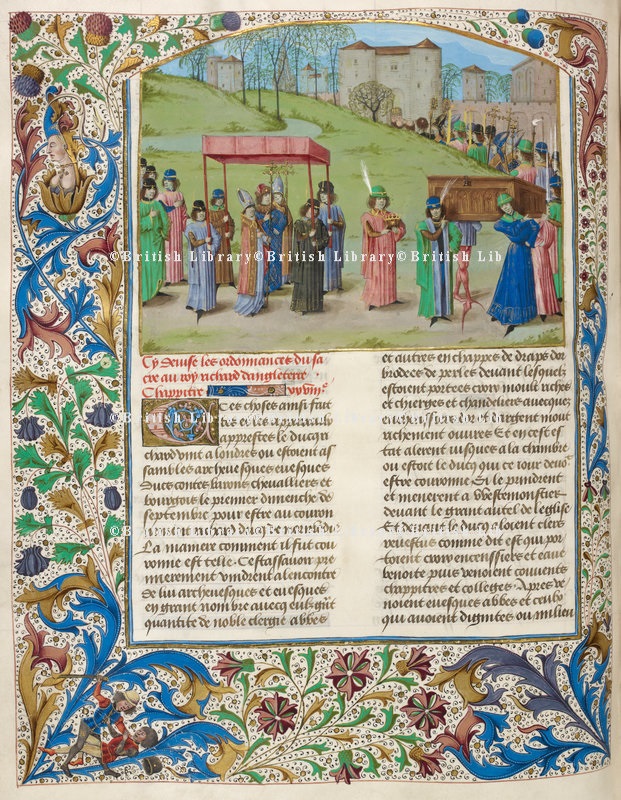
[The Coronation Procession of Richard I with the Barons of the Cinque Ports (Kent and Sussex), MS Royal 15. E. IV, fol.257v / courtesy of the British Library archive].
Important paraphernalia symbolised some of the key features of medieval kingship.
Question:
What royal symbols can you identify in the source above on the coronation of Richard? List them.
Homage: In the Britannica entry, it explains homage and its related notion "fealty" as follows:
Homage and fealty, in European society, solemn acts of ritual by which a person became a vassal of a lord in feudal society. Homage was essentially the acknowledgment of the bond of tenure that existed between the two. It consisted of the vassal surrendering himself to the lord, symbolized by his kneeling and giving his joined hands to the lord, who clasped them in his own, thus accepting the surrender.
Fealty was an oath of fidelity made by the vassal. In it he promised not to harm his lord or to do damage to his property. Although homage had to be rendered directly to the lord, fealty could be given to a bailiff or steward. The lord then performed a symbolic investiture of the new vassal, handing over to him some object representing his fief. The whole procedure was a recognition of both the assistance owed by the tenant to his lord and the protection owed by the lord to the tenant.

[Richard I paying homage to Philip for Normandy. Source: Chroniques de France ou de Saint Denis. Originally published/produced in France (Paris?); 1487, MS Royal 20 E.III, f.155v / Courtesy of the British Library archives]
It was believed that monarchs were chosen by God to protect and govern the people (The divine right of kings). This was a political and religious doctrine of royal and political legitimacy. It asserts that a monarch has a divine mandate to rule, i.e. he is not subject to any earthly authority because it is derived from God's will. The king is thus not subject to the will of his people, the aristocracy (barons, lords), or any other estate of the kingdom. It also implies that only God can judge an unjust king and that any attempt to depose, dethrone or restrict his powers runs contrary to the will of God and may constitute a sacrilegious act.
Duties: The expected duties of a monarch included:
1] leader of the royal army who would lead it out into battle. He would be a soldier and would fight to win land for the crown and defend it from threat and invasion.
2] governor of the kingdom. He would have to make fair and just decisions on how to run the kingdom; decisions that mostly involved raising funds and protecting the kingdom.
3] judge of all disputes. The court judges would implement his decrees and judgments in order to settle disputes and punish criminals.
Qualities: some of the key qualities a medieval monarch would be expected to have included:
- bravery.
- popularity.
- fairness.
- religiosity.
- ruthlessness.
- charisma.
Refer as well to the sections on Richard's personal qualities and leadership.
What other qualities would be expected of a medieval king? List another six.
(Try not to be anachronistic in thinking about what qualities would be needed).
Succession
Under medieval monarchical rule, securing the throne often occurred through contention - i.e. succession was often disputed and rival claimants would forcibly try and seize the throne. The contention would also sometimes lead to a succession war or a dynastic struggle.
In the case of Richard, he sought to acquire his share of his father's estates and territory through a revolt - supported by his mother and brothers.

 IB Docs (2) Team
IB Docs (2) Team
